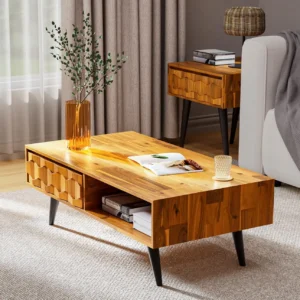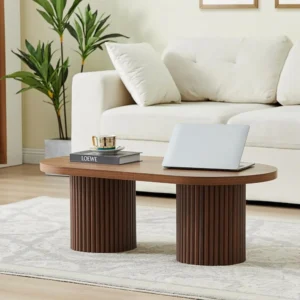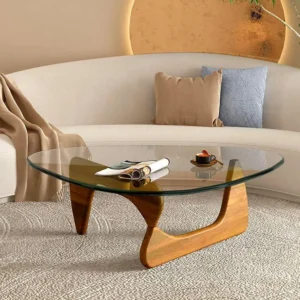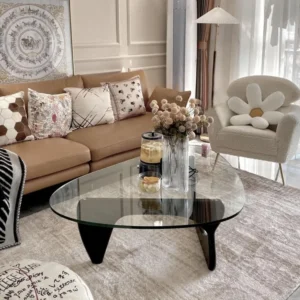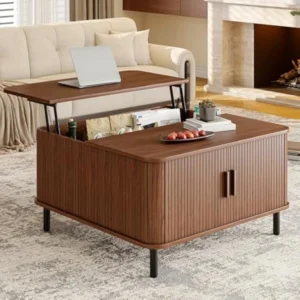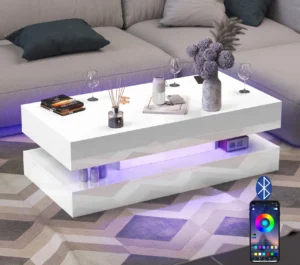Introduction: Why Black Mid-Century Coffee Tables Continue to Captivate Modern Spaces
The mid-century modern style, which flourished from 1945 to 1975, continues to inspire and influence interior design today with its clean lines, organic forms, and functional beauty. At the heart of many stylish living rooms sits perhaps one of the most enduring pieces from this era—the black mid-century coffee table.
These distinctive tables do more than simply provide a surface for books and beverages; they serve as statement pieces that anchor living spaces with timeless elegance. The combination of classic mid-century design principles with the versatility of black finishes creates pieces that effortlessly blend with various interior styles while maintaining their own distinctive character.
Black mid-century coffee tables offer a unique balance of form and function that few other furniture pieces can match. Their dark finishes highlight the clean lines and organic shapes that define the style, creating visual interest without overwhelming a space. Understanding the intelligent black mid-century coffee tables that best suit your needs requires examining their core features.
Throughout this guide, we’ll explore the essential elements that distinguish quality mid-century tables, from their signature silhouettes to construction techniques and functional features. Whether you’re drawn to the sleek simplicity or practical elegance of these pieces, discovering the various black mid-century modern coffee table styles will help you find the perfect centerpiece that balances aesthetic appeal with everyday functionality.
Defining Characteristics: Signature Silhouettes & Forms
The distinctive silhouettes of mid-century coffee tables represent one of their most recognizable features, combining geometric precision with organic fluidity in ways that continue to feel fresh and relevant decades after their introduction.
Geometric Precision
Mid-century coffee tables typically showcase several characteristic shapes:
- Rectangular and square designs feature clean edges that may be softened with rounded corners or gentle curves
- Round and oval tables offer a more fluid alternative while maintaining balanced proportions
- Kidney-shaped and amoebic forms introduce playful, organic elements that reflect mid-century’s embrace of natural inspiration
- Asymmetrical and geometric interpretations challenge conventional forms while maintaining functional surfaces
A defining characteristic of these tables is their low profile, typically standing between 14-18 inches tall. This intentionally grounded height creates a relaxed, approachable aesthetic that invites casual gathering while maintaining visual balance with surrounding seating.
The black finish on these pieces serves a dual purpose—it emphasizes the distinctive silhouettes while allowing the form itself to take center stage. When viewing a black mid-century table, the eye is drawn to the overall shape rather than being distracted by wood grain or pattern, highlighting the intentional proportions and thoughtful lines that define the design.
The careful relationship between form and proportion extends beyond visual appeal to practical function. The typical dimensions of these tables—whether rectangular pieces measuring approximately 48 inches by 24 inches or round tables with 36-inch diameters—reflect a deliberate balance between providing adequate surface area while maintaining the open, uncluttered feeling prized in black coffee tables mid-century interiors.
When exploring different options, considering the extensive variety of mid-century modern black coffee tables available helps you identify which silhouette best complements your existing furniture while maintaining authentic mid-century character.
Leg Designs: The Foundation of Mid-Century Style
The legs of a mid-century coffee table are much more than functional supports—they’re defining design elements that contribute significantly to the piece’s overall character and visual appeal. These distinctive underpinnings often become the most recognizable feature of authentic mid-century design.
Signature Leg Styles
Tapered legs represent perhaps the most iconic mid-century element. These legs start thicker at the top and gradually narrow toward the floor, often angled outward (splayed) to create a sense of dynamic energy and stability. This subtle flaring creates the distinctive “stance” immediately recognizable as mid-century.
Hairpin legs, inspired by industrial design, feature thin metal rods bent into elegant shapes that provide surprising strength while creating visual lightness. Black hairpin legs offer dramatic contrast against lighter table surfaces or blend seamlessly with darker tops.
Wishbone or V-shaped legs introduce sculptural elements through their angular forms. These legs typically connect to the tabletop at a single point before splitting into a supportive stance, creating interesting negative space beneath the table.
Pedestal bases offer an alternative approach, centralizing support through a single column that often flares at the bottom for stability. This design allows for more flexible seating arrangements and unobstructed leg room.
Solid or plinth bases, though less common, provide grounding stability and a sense of substantial presence. These can range from sleek geometric forms to more sculptural interpretations.
The black finish on table legs serves different visual purposes depending on the design. On thinner elements like hairpin or tapered legs, black can make them appear more delicate and less visually intrusive. Conversely, on chunkier supports, black finishes can emphasize boldness and create dramatic silhouettes.
Another subtle but important design consideration is leg placement—whether they’re positioned flush with the table’s edges or inset from the perimeter. Inset legs create a floating effect where the tabletop appears to extend beyond its support, while flush placement creates a more contained, unified appearance. Both approaches reflect intentional design choices that influence how the piece occupies space.
The various mid-century modern rectangular coffee tables available today showcase these different leg treatments, from minimal spindle legs to more substantial geometric supports, each creating a different visual impression while maintaining authentic mid-century principles.
Materials & Construction: What Creates Quality in Black Mid-Century Tables
The enduring appeal of black mid-century coffee tables stems largely from their thoughtful material selection and meticulous construction techniques. Understanding these elements helps distinguish quality pieces that will retain both their beauty and functionality for years to come.
Primary Materials
Wood Varieties
The foundation of many mid-century tables begins with carefully selected hardwoods. When finished in black, different species reveal distinctive characteristics:
- Walnut maintains subtle grain visibility even through ebonizing or black staining, creating depth and texture beneath the dark surface
- Oak offers pronounced grain patterns that create textural interest even when darkened
- Teak provides exceptional durability with a smooth finish that takes black stains elegantly
- Ash features straight grain patterns that create subtle linear texture through dark finishes
Metal Elements
Metal components contribute both structural support and design interest:
- Steel elements with black powder-coating or paint provide durable, consistent finishes
- Brass accents, even when minimally visible, introduce warmth against black surfaces
- Aluminum offers lightweight strength for more delicate designs
Glass Components
Many mid-century tables incorporate glass elements:
- Clear glass creates visual lightness, especially when paired with substantial black frames
- Smoked glass enhances the sophisticated look of black tables with subtle translucency
- Tinted black glass provides dramatic surfaces with reflective qualities
Engineered Materials
Quality modern interpretations often utilize:
- Premium veneers over stable substrates, allowing for consistent grain patterns
- High-grade laminates that provide exceptional durability while maintaining aesthetic appeal
Construction Quality Indicators
Authentic mid-century pieces—whether vintage or contemporary—showcase specific construction techniques that signal quality:
Joinery Methods
The connection points between components reveal craftsmanship level:
- Mortise and tenon joints create strong, lasting connections without visible hardware
- Dovetail joints, particularly in drawers, demonstrate meticulous attention to detail
- Finger joints provide both strength and visual interest at corner connections
Finishing Techniques
Quality black finishes exhibit:
- Even application without drips or inconsistencies
- Appropriate sealing that prevents chipping or peeling
- Subtle sheen variation depending on intended effect
- Protective clear coats that resist water rings and everyday wear
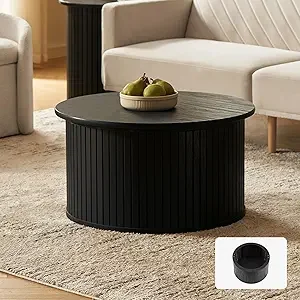
When examining construction quality, weight often serves as a reliable indicator—solid mid-century modern solid wood coffee tables offer substantial heft that provides stability during use. Similarly, the features large midcentury modern tables incorporate typically demonstrate how thoughtful engineering and material selection contribute to both aesthetics and longevity.
Surface Finishes: The Spectrum of Black in Mid-Century Design
Black mid-century coffee tables showcase remarkable variation within what might initially seem like a simple color choice. The specific finish applied to a black table dramatically affects both its visual presence and practical performance in daily use.
The Range of Black Finishes
Matte Black
This understated finish absorbs rather than reflects light, creating a soft, contemporary appearance. Matte black surfaces:
– Provide a modern, sophisticated look
– Hide fingerprints and minor imperfections more effectively
– Create subtle contrast with both textural and smooth elements
– Blend seamlessly into various design aesthetics
Satin Black
With a subtle sheen that’s neither flat nor glossy, satin finishes strike a versatile balance:
– Offer gentle reflection that enhances dimensional features
– Perform consistently across various lighting conditions
– Provide moderate resistance to showing fingerprints and dust
– Create visual depth without becoming a focal point themselves
High-Gloss Black
These dramatic, reflective finishes make bold statements in interior spaces:
– Create mirror-like surfaces that reflect light and surrounding objects
– Amplify the perception of space in smaller rooms
– Provide striking contrast against matte or textured elements
– Make strong design statements that command attention
Textured Black
Some finishes incorporate subtle texture for added dimension:
– Create tactile interest through slight grain patterns or intentional texture
– Disguise minor wear and imperfections effectively
– Add visual complexity while maintaining the sophistication of black
– Reduce the appearance of fingerprints and everyday smudges
The interaction between light and different black finishes creates varying atmospheres within a space. Matte finishes tend to recede visually and create grounding elements, while glossier surfaces become dynamic elements that reflect and play with available light. This relationship with light means the same table design can create dramatically different effects depending on its specific black finish.
Each finish type also carries different maintenance implications. High-gloss surfaces, while striking, typically show dust and fingerprints more readily than matte options. Textured finishes generally require deeper cleaning to address particles that settle into surface variations but disguise day-to-day smudges more effectively.
When considering mid-century modern glass top coffee tables, the contrast between black metal or wood frames and transparent surfaces creates particularly striking visual interest. The finish on these black elements directly influences how dramatically the glass stands out within the overall design.
Functional Features: Storage Solutions & Versatility
Beyond their aesthetic appeal, black mid-century coffee tables often incorporate thoughtful functional elements that address practical needs while maintaining clean design lines. These features transform coffee tables from simple surfaces to multifunctional pieces that enhance daily living.
Innovative Storage Options
Open Shelving
Many mid-century designs incorporate exposed lower shelves that provide:
– Accessible storage for frequently used items like remote controls or magazines
– Display opportunities for decorative objects or small collections
– Visual weight distribution that maintains the characteristic mid-century lightness
– Easy cleaning access compared to enclosed storage
Hidden Compartments and Drawers
More sophisticated designs feature concealed storage that preserves clean lines:
– Smooth-gliding drawers, often with push mechanisms rather than visible hardware
– Compartments integrated into the table’s structure without disrupting its silhouette
– Clever divisions for organizing smaller items like game controllers or charging cables
– Felt-lined drawers in premium pieces that protect delicate items
Lift-Top Mechanisms
Addressing contemporary needs, many black mid-century tables feature adjustable surfaces:
– Hinged portions that raise to comfortable working or dining height
– Hydraulic systems that provide smooth, controlled movement
– Dual-purpose designs that reveal storage while creating usable elevated surfaces
– Space-efficient solutions for multipurpose rooms and smaller living spaces
Nesting Designs
Some mid-century tables come in coordinated sets:
– Smaller tables that tuck neatly beneath larger surfaces when not in use
– Complementary shapes that can be arranged in various configurations
– Consistent black finishes that create cohesive visual groupings
– Flexible options for entertaining or accommodating different activities
Multi-Tiered Surfaces
Distinctive mid-century designs often separate functional areas:
– Split-level surfaces that create visual hierarchy and separation
– Designated areas for display versus practical use
– Architectural interest through level changes and material combinations
– Opportunity to incorporate contrasting materials within a unified design
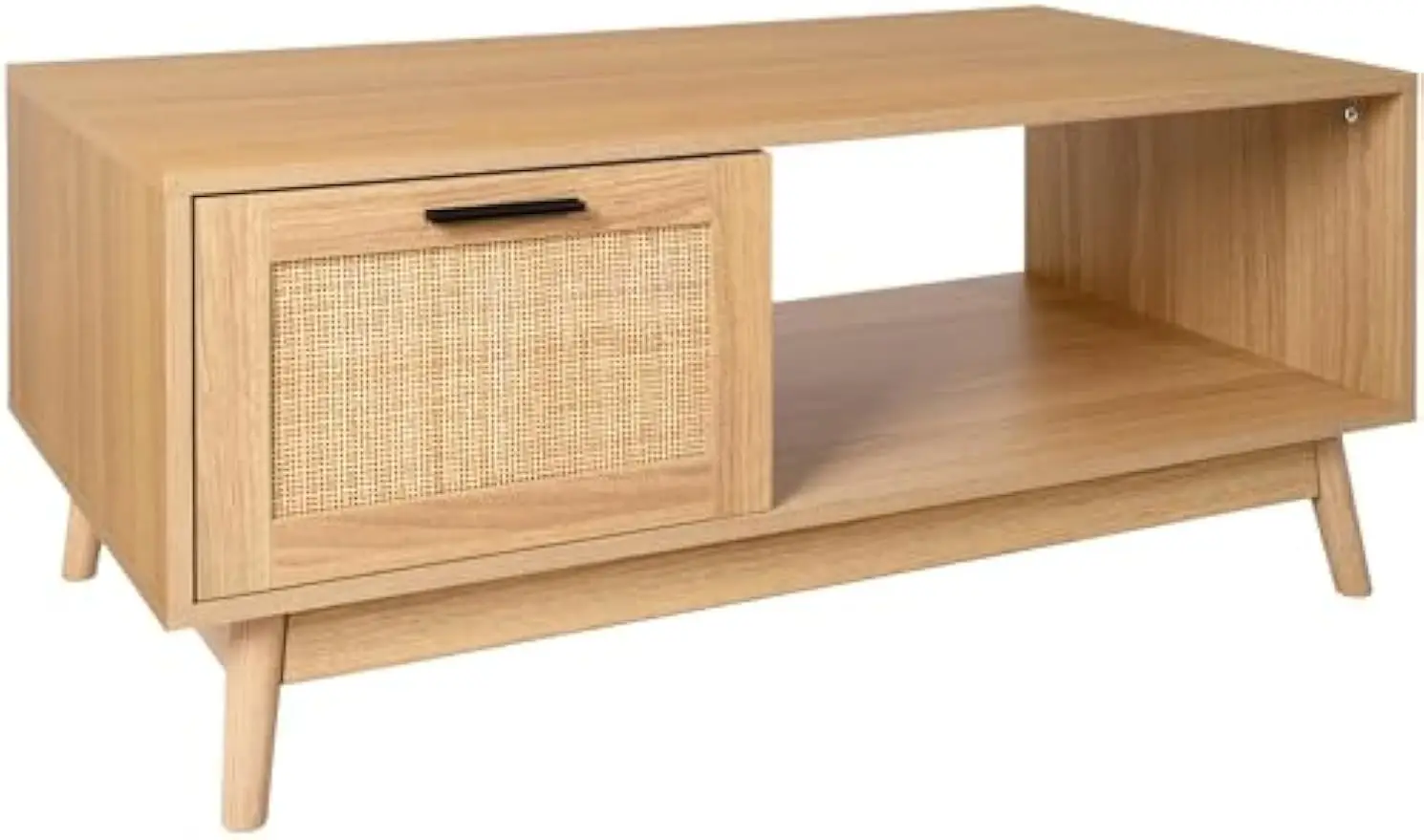
The black finishes on these functional elements often serve strategic purposes—concealing storage mechanisms, unifying disparate materials, or drawing attention to innovative features. When exploring mid-century modern lift-top coffee tables, you’ll notice how the dark finishes help maintain visual cohesion even as parts move and transform.
These practical features represent how mid-century design principles adapt to contemporary needs without sacrificing aesthetic integrity. The mid-century lift-top coffee tables available today demonstrate how functional innovation can coexist with faithful adherence to classic design principles.
Mid-Century Modern Solid Wood Coffee Tables, Mid-Century Modern Teak Coffee Tables
$879.95 Select options This product has multiple variants. The options may be chosen on the product pageMid-Century Modern Danish Coffee Tables, Mid-Century Modern Oval Coffee Tables, Mid-Century Modern Solid Wood Coffee Tables
$390.05 Select options This product has multiple variants. The options may be chosen on the product pageMid-Century Modern Glass Top Coffee Tables, Mid-Century Modern Glass Top Side & End Tables
$460.58 Select options This product has multiple variants. The options may be chosen on the product pageMid-Century Modern Glass Top Coffee Tables, Mid-Century Modern Vintage Coffee Tables, Mid-Century Modern Vintage Side & End Tables
$725.36 Select options This product has multiple variants. The options may be chosen on the product pageMid-Century Modern Lift Top Coffee Tables, Mid-Century Modern Square Coffee Tables
$454.73 Select options This product has multiple variants. The options may be chosen on the product pageMid-Century Modern Large Coffee Tables, Mid-Century Modern Rectangular Coffee Tables
$603.26 Select options This product has multiple variants. The options may be chosen on the product page
Size & Scale: Selecting Proportions for Your Space
Selecting a black mid-century coffee table with appropriate dimensions ensures both visual harmony and practical functionality within your living space. Understanding standard measurements and proportion relationships helps create balanced, comfortable arrangements.
Key Dimensional Considerations
Height Proportions
Mid-century coffee tables typically maintain a characteristic low profile:
– Standard heights range from 14-18 inches (35-46 cm)
– Ideally positioned 1-2 inches (2.5-5 cm) below cushion height of surrounding seating
– Lower heights create relaxed, casual atmospheres characteristic of mid-century spaces
– Tables intended primarily for dining or working while seated may be slightly higher
Surface Area Dimensions
Table width and length should coordinate with surrounding furniture:
– Rectangular tables typically measure between 42-54 inches (107-137 cm) long and 18-30 inches (46-76 cm) wide
– Round tables generally range from 30-42 inches (76-107 cm) in diameter
– Ideal length is approximately two-thirds the length of the primary sofa
– Table width should allow 18-24 inches (46-61 cm) clearance from seating edges for comfortable leg room
Clearance Requirements
Proper spacing ensures comfortable movement around the table:
– Maintain 18-24 inches (46-61 cm) between the table edge and seating
– Allow 30-36 inches (76-91 cm) for primary walkways around the arrangement
– Consider 12-15 inches (30-38 cm) minimum side clearance where traffic is limited
– Ensure sufficient space to fully extend any moving parts like lift-tops or drawers
The visual weight of black finishes can influence perceived scale—darker surfaces often appear more substantial than lighter ones of identical dimensions. In smaller spaces, consider tables with visible legs rather than solid bases to create a sense of openness, as the visible floor space beneath helps maintain visual lightness.
Different room configurations benefit from specific table shapes. L-shaped sectionals often pair well with round or oval tables that echo their curved elements, while straight-line seating arrangements typically complement rectangular or square tables that reinforce linear geometry.
When styling black mid-century coffee table arrangements, consider both the physical dimensions and the visual presence created by the table’s form, materials, and finish. The goal is creating balanced proportions where the coffee table feels appropriately scaled to both the room and its surrounding furniture.
Styling Versatility: How Black Mid-Century Tables Complement Various Interiors
One of the most compelling attributes of black mid-century coffee tables is their remarkable adaptability across diverse interior styles. Their refined forms and neutral coloration allow them to enhance various design approaches while maintaining their distinctive character.
Styling Applications Across Design Styles
In Minimalist Modern Settings
Black mid-century tables excel in clean, contemporary spaces by:
– Creating anchoring focal points without introducing visual clutter
– Providing defined boundaries in open floor plans
– Offering textural contrast against monochromatic backgrounds
– Introducing architectural interest through their distinctive silhouettes
With Eclectic Décor
Among mixed styles and periods, black mid-century pieces serve as:
– Grounding elements that provide visual stability
– Neutral bridges between disparate furniture styles
– Sophisticated counterpoints to more ornate or colorful pieces
– Form-focused items that complement pattern-rich environments
In Neutral Palettes
Against beige, gray, or white backgrounds, black tables:
– Add definition and visual weight to prevent blandness
– Create necessary contrast that enhances depth perception
– Introduce dramatic punctuation in otherwise subtle spaces
– Highlight the importance of form when color variety is limited
With Colorful Schemes
In vibrant interiors, black mid-century tables provide:
– Sophisticated counterbalance to bold color choices
– Visual rest areas that prevent overwhelming sensations
– Grounding elements that enhance color appreciation through contrast
– Classic forms that prevent colorful schemes from appearing trendy or temporary
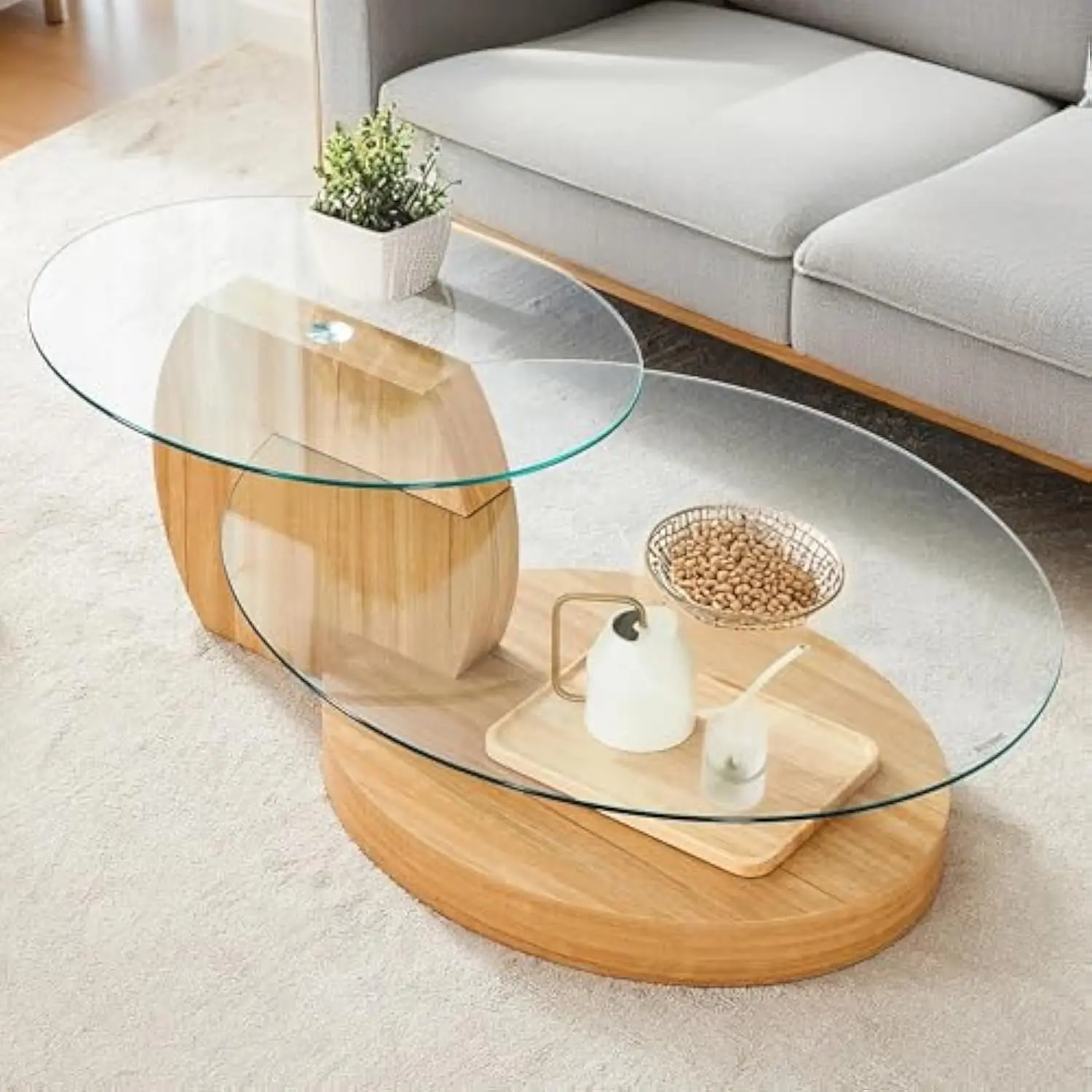
When styling these versatile pieces, consider highlighting their distinctive mid-century details through thoughtful accessorizing. Geometric vessels, sculptural objects, and carefully curated books can emphasize the table’s clean lines and intentional design. The key lies in maintaining visual balance—allowing enough negative space to appreciate the table’s form while adding elements that complement its character.
Black tables naturally create visual hierarchy in room designs by providing strong contrast points that draw the eye. This can be particularly valuable in establishing focal areas within larger spaces or directing attention in rooms with multiple functional zones.
For specific approaches to enhancing these versatile pieces, exploring ideas for decorating black mid-century coffee tables provides practical inspiration. Understanding which styles go well mid-century modern furniture helps create cohesive interiors that feel intentionally designed rather than randomly assembled.
Authenticity vs. Inspiration: Recognizing True Mid-Century Features
As black mid-century coffee tables continue gaining popularity, distinguishing between authentic designs, faithful reproductions, and contemporary interpretations becomes increasingly valuable. Each category offers distinct benefits and appeals to different priorities.
Categories of Mid-Century Design
Vintage Original Pieces (1945-1975)
Authentic tables from the original mid-century era feature:
– Materials consistent with period manufacturing (particularly walnut, teak, and oak)
– Construction techniques reflecting pre-mass production craftsmanship
– Patina and character developed through decades of use
– Original proportions that defined the mid-century aesthetic
– Potential collector value beyond functional considerations
Faithful Reproductions
Quality reproductions of classic designs maintain:
– Precise adherence to original proportions and dimensions
– Authentic material selections matching original specifications
– Traditional construction techniques even when manufactured with modern tools
– Faithful finishing approaches that respect original appearances
– Intentional preservation of distinctive design elements
Contemporary Interpretations
Modern pieces with mid-century inspiration offer:
– Updated proportions that may accommodate contemporary living needs
– Innovative material combinations while maintaining mid-century silhouettes
– Enhanced functionality addressing modern requirements (device charging, media storage)
– Fresh perspective on classic forms through subtle reinterpretation
– Often more accessible price points than authentic vintage pieces
Recognizing authentic mid-century design principles involves identifying key characteristics such as clean lines, organic curves, minimal ornamentation, and emphasis on function. True mid-century pieces, whether original or reproduction, typically feature tapered legs, intentional proportions, and materials selected for both beauty and performance.
The value proposition differs across these categories. Vintage originals offer historical significance and potential investment value, while reproductions provide classic design without the potential fragility of aged pieces. Contemporary interpretations often better accommodate modern technology and living patterns while maintaining mid-century aesthetic principles.
For those drawn to historical authenticity, exploring mid-century modern vintage coffee tables offers insights into genuine period designs. These pieces demonstrate how the original mid-century vision continues influencing furniture design generations later, proving the enduring appeal of these distinctive tables.
Selection Guide: Matching Black Mid-Century Tables to Your Lifestyle
Finding the ideal black mid-century coffee table involves aligning design preferences with practical lifestyle considerations. This framework helps identify which features matter most for your specific situation.
Decision Framework
Primary Use Assessment
Consider how you’ll primarily use the table:
– Display and decoration (prioritize surface material and visual impact)
– Regular functional surface (emphasize durability and maintenance requirements)
– Work or dining surface (consider height adjustability and stability)
– Storage solution (focus on drawer capacity and organization features)
– Multipurpose use (look for adaptable designs with versatile features)
Space Considerations
Evaluate your room constraints and circulation needs:
– Measure clearance paths carefully before selecting dimensions
– Consider how the table affects visual weight in the space
– Assess whether legs or base style impacts movement patterns
– Determine if shape (round vs. rectangular) better suits traffic flow
– Evaluate whether nesting or expanding options would benefit your space
Maintenance Capabilities
Be realistic about care requirements:
– High-gloss surfaces show fingerprints and require frequent wiping
– Wood surfaces may need occasional polishing or refinishing
– Glass tops require regular cleaning to maintain clarity
– Consider how the table will respond to common incidents (spills, heat marks)
– Assess compatibility with your regular cleaning routine
Design Integration
Consider how the piece fits your overall aesthetic:
– Identify which mid-century era or sub-style most appeals to you (early, mainstream, or late)
– Determine whether contrast or coordination with existing furniture is preferred
– Consider how the table’s lines complement architectural features
– Assess whether material choices harmonize with your interior palette
– Evaluate whether the piece will remain relevant through potential décor changes
When making your selection, prioritize features that genuinely serve your daily needs rather than focusing solely on aesthetic appeal. The most successful mid-century pieces combine beautiful design with practical functionality—a balance that has contributed to their enduring popularity.
For curated options that meet these various needs, exploring the best black mid-century coffee tables can provide guidance on quality pieces across different categories and price points.
Care & Maintenance: Preserving Black Finishes on Mid-Century Tables
Proper maintenance ensures your black mid-century coffee table maintains its sophisticated appearance and structural integrity for years to come. Different materials and finishes require specific care approaches.
Material-Specific Care Guidelines
Wood Care for Black Surfaces
For ebonized or painted wood tables:
– Dust regularly with a soft, slightly damp microfiber cloth
– Clean spills immediately to prevent potential staining or finish damage
– Use coasters under beverages to prevent moisture rings
– Apply furniture wax specifically formulated for dark finishes every 3-6 months
– Avoid silicone-based products that can create build-up on black surfaces
Metal Component Maintenance
For black metal legs or accents:
– Wipe with a soft cloth dampened with mild soap solution when needed
– Dry thoroughly to prevent water spots or potential oxidation
– Touch up any chips in powder-coated finishes promptly to prevent spreading
– Apply paste wax to unsealed metal parts to prevent fingerprint accumulation
– Keep metal joints tightened to maintain structural integrity
Glass Surface Care
For tables with glass elements:
– Clean with ammonia-free glass cleaner or diluted white vinegar solution
– Use lint-free cloths to prevent streaking on black glass or clear surfaces
– Support glass properly when cleaning to prevent stress on mounting points
– Check edge seals regularly on laminated glass components
– Avoid dragging objects across glass surfaces to prevent scratches
Damage Prevention
Practical preventive measures include:
– Using felt pads under decorative objects that contact the table surface
– Implementing heat-resistant trivets under hot items
– Placing protective mats under items that might scratch or damage finishes
– Repositioning decorative items periodically to prevent uneven color aging
– Avoiding direct sunlight exposure that can fade black finishes over time
For addressing minor wear issues, appropriate touch-up approaches depend on the specific finish. Matte and satin black surfaces often benefit from specialized touch-up markers designed for furniture, while high-gloss finishes may require professional restoration for noticeable damage.
Implementing these care strategies ensures the continued beauty of your table while preserving its functionality. For additional guidance on maintaining various black finishes, the information on maximizing black mid-century coffee tables provides specific techniques for addressing common maintenance challenges.
Why Black Mid-Century Coffee Tables Remain Relevant Today
The enduring appeal of black mid-century coffee tables transcends passing trends, speaking to fundamental principles of good design that remain as relevant today as when they first appeared. These pieces continue to resonate with contemporary spaces because they successfully balance form and function in ways few other furniture styles achieve.
Their clean, intentional lines provide visual clarity that complements today’s desire for uncluttered, purposeful spaces. The sophisticated presence of black finishes creates dramatic focal points without overwhelming surroundings, allowing these tables to enhance rather than compete with their environments.
Perhaps most significantly, these pieces represent sustainable design thinking through their timeless appeal and durable construction. In an era increasingly concerned with reducing waste and disposable consumption, well-crafted mid-century tables offer lasting quality that can be enjoyed for generations rather than years.
Understanding the black mid-century coffee table design principles helps explain why these pieces continue finding new audiences. Their purposeful construction, thoughtful proportions, and elegant simplicity create furniture that transcends momentary trends, offering both aesthetic satisfaction and practical functionality that remains as valuable today as when first conceived.
By recognizing the essential features that define these distinctive tables, you’re better equipped to select pieces that will serve both your immediate needs and long-term design vision. The black mid-century coffee table’s remarkable ability to blend historical design integrity with contemporary functionality ensures its continued relevance in thoughtfully designed interiors.


